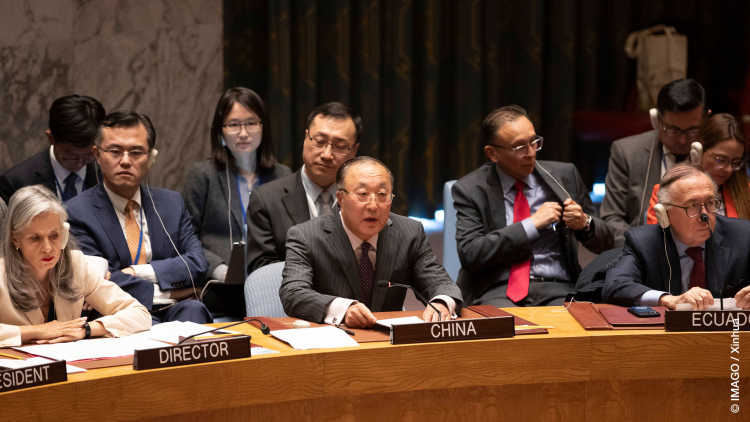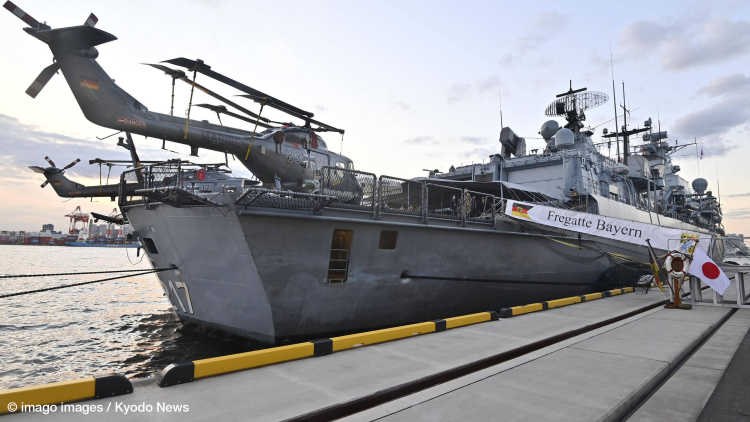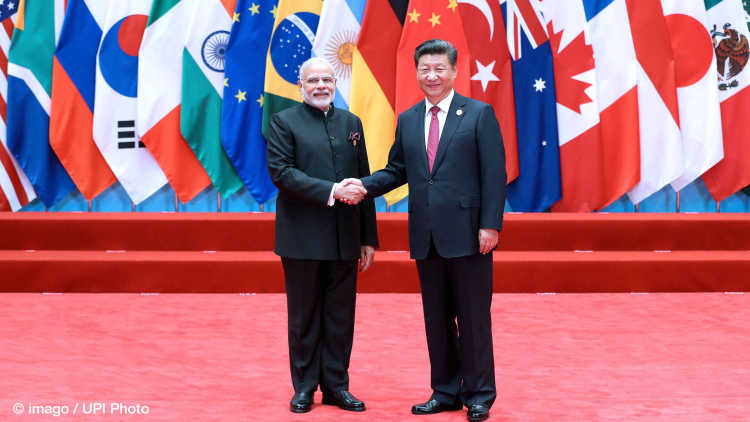- Startseite
- Publikationen
- GIGA Focus
- The Indo-Pacific: Confidence-Building in Times of Growing Conflict Potential
GIGA Focus Asien
The Indo-Pacific: Confidence-Building in Times of Growing Conflict Potential
Nummer 6 | 2023 | ISSN: 1862-359X

The Indo-Pacific is a large and diverse region with multiple simmering conflicts. Growing geopolitical rivalries, militarisation, nuclear modernisation, and similar could lead to their escalation, with severe impacts also on Europe’s economy and security. Upgrading existing Confidence-Building Measures (CBMs) is needed to increase stability. Europe should use its albeit limited impact to assist.
Simmering conflicts in the region range from territorial disputes between China, India, and Pakistan to territorially contested waters and islands in the South China Sea bearing further crisis-escalation risks. North Korea’s aggressively pursued nuclear and ballistic missile programme threatens its neighbours and possibly the US.
Rapid military advancement among the key countries active in the region, regarding nuclear and non-nuclear weapon systems alike, will fundamentally challenge regional defence and deterrence postures.
While the status quo and fragile regional stability have worked in the absence of overarching institutionalised security arrangements until now, the future is less certain.
Manyfold regional and subregional institutions have performed well in the past in securing peace, among them ASEAN, the Six-Party Talks with North Korea, and the Asia Regional Forum. New formats such as the Quadrilateral Security Dialogue between Australia, India, Japan, and the US or the Australia, UK, US pact are advancing security cooperation in the Indo-Pacific.
Doubts remain, however, about whether they will be able to manage new risks in the face of geopolitical changes and new technological and military developments.
Policy Implications
Fostering confidence-building across the region through modernised and revitalised CBMs can help mitigate the conflict risks in the region. All actors should take these risks seriously and identify mechanisms to (re-)establish basic confidence and mutual trust. European decision makers should assist here by signalling their readiness to work with the region more closely on securing peace and stability.
A Region in Change
As the Economist pointed out:
Well before Russia’s invasion of Ukraine, doubts were growing in Asia about the durability of the American-led order that has largely kept the peace since the Vietnam war. (The Economist 2022)
There are manifold reasons for the assumption that the status quo in Asia and the Indo-Pacific will fundamentally change in the next few years or latest decades. This could include the outbreak of one or several subregional conflicts, their geographical escalation, as well as direct conventional or nuclear conflict between China and the US, India and China or Pakistan, or else on the Korean Peninsula. Some commentators warn that a major conflict is nearly inevitable unless the major powers agree on “guardrails” for their policies (Rudd 2021). Any escalation even of a smaller regional conflict could have severe impacts on Europe’s economy and security, as the Indo-Pacific produces 30 per cent of global GDP. Major trading routes run through the region and large amounts of key resources, such as rare earths or advanced integrated circuits, are located or produced in the region (in China and Taiwan, respectively). Every day, more than 2,000 ships use its maritime routes from and to Europe. Europe and EU member states therefore have a major interest in fostering peace and stability in the region.
Theatres of Regional Competition and Increasing Risks of Conflict
China’s assertive conduct in the South China Sea (SCS) regarding contested islands, manoeuvres in the East China Sea across the Taiwan Strait (such as frequent incursions into Taiwan’s Air Defense Identification Zone), and military build-up in the Himalayas – combined with its “bullying mercantilist approach on economic relations including along the Belt and Road” (The Economist 2022) – seem to indicate the country deliberately accepting increasing risks regarding its neighbours or even accidental conflict. China is building military installations on several previously uninhabited islands or underwater shelfs along the so-called Nine-dash line in the SCS, for which it claims (contested) historical rights. In the Himalayas, it is also enhancing its military presence in contested border areas with India. Severe encounters with the Indian Army already took place in 2020. It is also increasing the number of incursions by military-protected fishing and research ships into the exclusive economic zones (EEZs) of countries in the SCS such as the Philippines and Vietnam, despite their strong protests. Serious naval incidents have happened in the past that could have rapidly escalated.
China–US relations are becoming increasingly tense on many fronts, from technological competition and restrictions like with the “CHIPS and Science Act” of 2022 to increasing US engagement with Taiwan (such as US House of Representatives Speaker Nancy Pelosi’s visit in August 2022, with Chinese military exercises in reaction). Since World War II ended, the US has maintained a strong presence and impact in the region by running a system of alliances and bases (“hubs and spokes”) over the past seven decades or so. This regional US presence is now heavily contested by China. Close encounters between naval vessels but also fighter and reconnaissance planes in international waters and air space in the region are happening ever more regularly and have the potential to lead to accidental conflict.
North Korea is progressing rapidly with its ballistic and nuclear-weapon programmes, diverse and frequent missile tests, and launching of dual-use satellites – including in May 2023 the (failed) launch of a spy satellite. It is enhancing its conventional military and naval activities and is increasingly showing a higher risk-readiness vis-à-vis South Korea, Japan, and the US. It continues to issue threats not only to South Korea but also to the US regarding massive military – even nuclear – attacks, should its regime come to be at risk.
South Korea therefore shows an outspoken interest in extended US nuclear deterrence, while public sentiment is to ponder nuclear-sharing arrangements and even indigenous nuclear weapons (Herzog and Sukin 2023). A recent South Korean agreement with the US by their respective presidents concluded on 26 April 2023 sees the US now providing enhanced security assurances, but this might only temporarily temper the mood. South Korea’s significant investment in intelligence, surveillance, reconnaissance (ISR) and in deterrence capabilities continues. Its reactions to North Korean provocations and tests are getting tougher, and not only verbally. Military manoeuvres and joint activities with the US have increased recently, too.
Japan is adjusting its defence posture and significantly investing in ISR and deterrence capabilities, despite the limits of its purely defence-oriented Constitution. It significantly increased its defence budget to USD 46 billion in 2022 (1.1 per cent of GDP) (SIPRI 2023a). It is intensifying military manoeuvres with the US, South Korea, and other countries in the region. Given Japan’s historic experience with the Hiroshima/Nagasaki bombings, indigenous nuclear weapons are rarely contemplated publicly in the country; it possesses, however, all the necessary capabilities and materials to build them, if it were to decide to do so.
Finally, there are the unresolved territorial conflicts between India and Pakistan and India and China respectively, ones that see regular resurgence and could spiral of control very quickly in times of crisis. The 2019 terrorist attack in and the accidental cruise-missile launch from India in March 2022 could have fuelled the India–Pakistan conflict. The 2020 incidents between China and India in the Himalayas, meanwhile, could have been a conflict trigger too.
Adding to those long-standing risks, newer developments might have an impact on regional security as well. The so-called AUKUS (Australia, UK, US) pact, enhancing security cooperation in many fields among these three countries, is setting a precedent for regional defence cooperation. With a phased deal providing Australia with a nuclear-powered submarine, it is raising questionsregarding nuclear proliferation in the region.
China and the US are both courting Pacific Island states, leading to the region’s increasing geopoliticisation and militarisation. New security arrangements are being negotiated by both sides with these island countries (such as China with Solomon Islands and the US with Papua New Guinea), and military bases contemplated. The EU and Germany are now also more actively engaged with the Pacific Island states, for example on climate change mitigation and non-traditional security issues (Hasenkamp and Köllner 2023).
The Quadrilateral Security Dialogue (QUAD) between Australia, India, Japan, and the US, which started as a disaster-relief initiative after the 2004 tsunami, is rapidly gaining traction. It is moving towards closer policy coordination on “hard” security issues, such as maritime intelligence-sharing. China sees the initiative as targeting its own regional interests. Rapid military advancement among the key countries active in the region, regarding nuclear and non-nuclear weapon systems alike, and the speed and reach hereof (outlined below) could fundamentally challenge national and regional defence and deterrence postures.
This long and non-exhaustive list of potential realms of conflict and new security developments demonstrates that there is ample reason to assume that the risk is growing of conflict accidentally breaking out in the region. This would have an enormous impact on global security. Enhancing confidence among the countries of the region and beyond is, therefore, more urgent than ever, and requires creative approaches and new ideas.
New Technological Developments and Militarisation Trends in the Indo-Pacific
China is not only rapidly enhancing its nuclear arsenal. It has also successfully tested new hypersonic weapons as well as manned and unmanned aerial and underwater vehicles, thus changing the equation regarding strategic stability in the region. Hypersonic weapons developed by China and Russia might become a game changer in regional conflict. Challenging missile defence and Anti-Access/Area Denial (A2/AD) systems (Saalman 2022), they can contest current US military supremacy. Missile-defence systems, such as the ones provided by the US to Japan and South Korea, might not be adequate against hypersonic and other new weapon threats.
Besides China, Russia, the UK, and the US are all also developing and deploying underwater drones to gain a strategic edge in the Pacific and beyond. Drones – both larger military and smaller “makeshift” ones, as can be witnessed currently in Russia’s war against Ukraine on both sides – are changing the nature of war. As such, they may also have an impact on the fragile balance of forces in the Indo-Pacific.
Fourth Industrial Revolution technologies – such as artificial intelligence, computational power, and robotics – are being increasingly applied in the naval sector. They have some potential to change the future of naval operations (Bowers and Kirchberger 2020). The growing integration of advanced non-nuclear technologies (such as automatisation and digitalisation) in weapon systems in air and sea, ISR, as well as nuclear command, control, and communication, create additional risks ranging from technical errors, to human–machine interactions, and new vulnerabilities via cyberattack (Anthony, Su, and Saalman 2023).
On the nuclear side, China is rapidly expanding its nuclear arsenal – now the third largest in the world by number – across all components and is building additional storage and launch silos for intercontinental ballistic missiles. It could have up to 1,500 warheads by 2035, up from currently over 400, according to a U.S. Department of Defense study. By the same year, China intends and is expected to complete the modernisation of all its military forces (SIPRI 2023b). The US is also modernising many components of its nuclear triad, as is Russia. India and Pakistan are gradually increasing their respective nuclear capabilities too, with India working on nuclear-powered and -capable submarines.
Doctrinal changes – or at least perceived reinterpretations of doctrines – are simultaneously taking place. Affirming worst-case assumptions, they could increase the risk of inadvertent nuclear escalation in the region through misinterpretations of actions, if the limited existing Confidence-Building Measures (CBMs) fail (Saalmann and Topychkanov 2021). The accidental launch of a nuclear-capable cruise missile by India into Pakistan in 2022, fortunately handled carefully by both sides, could have been such a case.
Military spending in Asia-Pacific has increased in the last decade by 45 per cent and arms sales to the East Asia and Oceania regions increased by 21 per cent and 25 percent between 2013 and 2017 and 2018 and 2022, respectively (SIPRI 2023a). Adding to that, military and naval exercises in the region among China and Russia, among the US and its regional allies, but also between smaller regional countries such as the recent 2nd ASEAN Multilateral Naval Exercise, have increased considerably in the past few years both in terms of extent and number of participants. European states’ navies are also increasingly participating in such exercises.
Existing Consultation and Confidence-Building Mechanisms in the Region
A myriad number of fora in the region allow for dialogue and consultation on security topics among countries of the region and beyond. Many could be of use to mediate in times of conflict and build confidence among regional actors. The fora range from regional or multilateral institutions such as ASEAN with its Defence Ministers Plus Meeting (ADMM+), the Asian Regional Forum (ARF), the East Asian Summit (EAS), to the Chinese- and Russian-led Shanghai Cooperation Organisation (SCO). They comprise bilateral, trilateral, or other “minilateral” mechanisms such as the (albeit stalled) Six-Party Talks on the North Korean nuclear issue, the QUAD, the South Korean-initiated North-East Asia Peace and Cooperation Initiative (NAPCI), the Indian Ocean Rim Association (IORA), and many others. Finally, subnational dialogue fora such as the so-called Shangri-la Dialogue (organised by the London- and Singapore-based IISS think tank), the Council for Security Cooperation in the Asia Pacific (CSCAP), the Asia-Pacific Round Table, and others can and should play a role in enhancing dialogue here.
All of these fora have their limits in terms of either membership or ability and efficacy in building confidence, having seen very mixed results in the past regarding the latter – as reflected in an extensive scientific literature hereon. The larger and the more open the fora are to countries with diverse interests (for example ARF and EAS comprise up to 27 members or above each), the more limited their ability is to deal effectively with acute crises. The EU and its member states are only part of a small number of regional fora, like the Asia-Europe Meeting (ASEM); thus, their influence when it comes to helping with confidence-building remains limited. On the other hand, many “minilaterals” often are not inclusive enough or exclude the key players and thus lack the ability to mediate (such as how the QUAD includes the US but not China; the SCO includes China and Russia but not the US) or they lack the power to implement decisions – as is the case with NAPCI, CSCAP, and the subnational fora.
The region is also characterised by ample instruments of confidence-building, particularly in the maritime domain. They range from the 2002 non-binding ASEAN-China Declaration on the Code of Conduct of Parties for the South China Sea, a Code of Conduct on Unplanned Encounters at Sea (CUES), to instruments not specific to the region. Examples of the latter are the United Nations Conference on the Law of the Sea (UNCLOS), the 1972 US-Soviet Incidents at Sea Agreement (INCSEA), or the 1977 International Regulations for Preventing Collisions at Sea (COLREG). Within the framework of ASEAN, many notification and other transparency instruments for naval and military activities have been developed, such as the 2018 ASEAN Guidelines for Air Military Encounters (GAME) and the 2019 ASEAN Guidelines for Maritime Interaction. Overall, more than 50 different fora and mechanisms on maritime security have been established as part of the broader ASEAN framework (Edwards 2022).
However, many instruments have shown their limits in terms of effectiveness. China, for example, did not participate in or indeed accept the UNCLOS Arbitration Tribunal decision of 2016 initiated by the Philippines regarding the “Nine-dash line’s” islands or maritime features in the SCS and Chinese claims. It is also dragging its feet regarding negotiations over the Code of Conduct for the South China Sea within the ASEAN framework, although both sides have recently committed to trying to achieve a result within the next three years. Furthermore, the coverage range of many CBMs is often limited to the military, naval, or air domains, such as the 2014 CUES, or they do not apply or work in “grey zones” such as conflicts over fishery zones, coastguard activities, the exploration of geological resources, and the like (Koh 2023).
From a conceptional perspective, the value and acceptance of CBMs generally depends on whether the gains for participants in pursuing them are higher than those from dismissing or ignoring them. They seem to work best if they create a “win-win” situation for all, such as the voluntary and treaty-based arms control, transparency, and CBMs reducing the speed of the arms race between the two blocs during the Cold War. If one or more country is trying to get an advantage from CBMs by hiding or blurring their real intentions, these measures might fail. One example is the Intermediate-Range Nuclear Forces Treaty from which the US withdrew in 2019 in view of the alleged clandestine development of medium-range ballistic missiles by Russia in the late 2010s.
As long as China continues to try driving the US out of the region, there is limited hope that effective CBMs – ones of value to both sides – can be negotiated that involve the two major powers. Also in view of the above, it is difficult to see how the smaller countries of the region – such as Malaysia, the Philippines, and Vietnam, but also Japan and others – will in the long run continue to believe in the value of and thus follow existing Codes of Conduct and transparency measures (for example in the maritime domain) while China is increasingly contesting and deliberately infringing on their territorial waters and EEZs. Thus, the relevance of existing regional CBMs might only further decrease over time.
On the other hand, there are positive developments in the region too. Examples are the agreements between Indonesia and the Philippines and Indonesia and Malaysia regarding their overlapping territorial claims, which are a testimony to the basic confidence that can be established if the political will for it exists. China and Japan agreed in May 2023, for instance, on a hotline regarding incidents at sea. Also, at least among member countries themselves, the various CBMs established within the ASEAN Framework (ADMM+ and similar) seem to work overall within their respective limited geographical and thematic scopes (Edwards 2022; Koh 2023).
Chances to Establish New or Upgrade Existing CBMs in the Region
The past few years have seen a particular “transparency and CBM” fatigue (Saalmann and Topychkanov 2021), both between India and Pakistan and between the US and Russia – particularly in the nuclear field. The end of a number of conventional and nuclear arms-control treaties in Europe and especially between the US and Russia is worrisome, as is their limited – or rather non-existent – nature in Asia. Every instance of a lack of transparency can lead to misperceptions and false risk assessments as regards adversaries’ capabilities and intentions. The Russian war against Ukraine has shown this clearly. In addition, the latter has only sped up ongoing reductions in arms control and transparency mechanisms within the OSCE framework. Fortunately, the US is still trying to “save” and extend the last existing US–Russia arms-control treaty, “New Start,” beyond 2026. As both of these countries are also important players in the Indo-Pacific, this is not without relevance to the region.
However, given China’s rapid nuclear and conventional arms build-up, and its growing political, economic, and technological importance globally, future treaties or arms-race limitations would need to involve and take account of China’s arsenals. So far, however, it has proved very reluctant to engage in that regard (Meier and Staack 2022). Confidence-building approaches – including nuclear-risk reduction mechanisms and limits to the use of new military technologies such as hypersonic weapons – will unequivocally require China’s involvement. This was also outlined in the recent China Strategy of the German Federal Government, published in July 2023. To get China “on board” given the country’s growing geopolitical rivalry with the US will require a lot of imagination and out-of-the-box thinking. Europe could contribute with concrete ideas of its own.
As outlined, maritime CBMs, Codes of Conduct, and transparency mechanisms have demonstrated their – albeit limited – effectiveness in East Asia and the SCS, and they are essentially based on traditional military and naval activities (Koh 2023). However, it is unclear as to how they can deal with newer technologies such as, for example, (often small) unmanned airborne and underwater drones. Those devices can, unlike ships or planes, often slip under the radar. They can also operate in the grey zone of supposedly “maritime research activities” that China is now undertaking in the SCS, not least to explore new geological resources around the contested islands. As it is unclear how countries will eventually react militarily to “spy operations” under the guise of civil research in their territorial waters or EEZs, this creates additional risks. Many regional states are also increasingly employing unmanned technologies to enhance their A2/AD systems.
The cyber domain is even less regulated, and as such not yet covered by effective CBMs – although extensive efforts, mainly targeted at the civilian arena, are ongoing here within the ASEAN framework. Their aim is to ensure a more than just basic level of transparency and readiness, as outlined in the 2017 ASEAN Declaration to Prevent and Combat Cybercrime and the ASEAN Cyber Security Cooperation Strategy 2021–2025. Cyberattacks against increasingly digitalised and automated weapon systems in air and sea, ISR, as well as naval command, control, and communication, are areas where at least some rules of behaviour are urgently needed – and not only in the Indo-Pacific – to minimise accidental risks (Anthony, Su, and Saalman 2023). However, given that these are all areas where the major military players are seeking a technological edge, the pursuit of such rules might unfortunately fall victim to global geopolitical rivalries.
Engaging the Region’s Middle Powers
In this rather dire situation, how to move ahead with enhanced regional confidence-building? One possible approach could be to start working among subregions with joint interests or on specific technologies or categories of arms, respectively. This work could take place within the framework of, or through the various engagements, strategies, and activities by, multiple Western and regional countries for the Indo-Pacific. Working via informal discussion is another possibility here, namely in the Shangri-la Dialogue or the Asia-Pacific Leadership Network (APLN). The various ASEAN fora, with their flexible formats, could also develop new ideas or update existing CBM instruments, given that the Association has been rather successful so far in balancing between the great powers (Koga 2022).
The starting point for modernising existing or negotiating new instruments may, as such, be best found among the smaller regional actors or in a subregional entity such as ASEAN taking the lead. Larger countries, and ultimately China and the US, could be invited to join later, provided the political will exists for that. In other words, a process of rule-setting by example could take place. Many ideas have been proposed in that regard both in the academic field as well as by regional leaders in recent years. Suggestions range from agreeing on guardrails for responsible behaviour in air and sea, voluntary arms-control commitments and self-restrictions on the use of new technologies, capacity-building in the cyber domain and regarding coastguard activities, to starting negotiations on new binding commitments vis-à-vis transparency and confidence-building in the naval and military arenas. It is up to the region’s respective leaders to demonstrate genuine political engagement on these proposals. The EU and its member states should, in their intensified security dialogues with the countries of the Indo-Pacific, encourage and support them in that regard, as outlined below.
The Role and Possibilities of Europe and Germany
Given that Europe is not part of many regional and subregional institutions in the Indo-Pacific, unfortunately its possibilities to assist directly in developing or revitalising CBMs are rather limited. However, it could contribute through sharing its experience with Cold War and post–Cold War confidence-building instruments for example within the OSCE framework, although these have encountered major setbacks in recent years and as one repercussion of the Russian war on Ukraine. Europe can also demonstrate – in particular through political messaging and even closer engagement at the political level in bilateral and regional dialogue, alongside also the supporting of government and informal exchange formats – that regional peace is of major interest to it and the world. In order to leverage more than just its primarily economic weight in the region, European leaders need, however, to create and maintain a unified position on the importance of the Indo-Pacific for the continent’s own security. The EU Strategy for Cooperation in the Indo Pacific adopted in 2021 is a very good start in that regard. It contains many suggestions on military and non-military tools for security cooperation (such as joint naval exercises, information-sharing, the fight against illegal fishing) and enhanced engagement with the region. It needs vigorous implementation and adequate funding. Projects like the EU Critical Maritime Routes in the Indian Ocean (CRIMARIO) and Enhancing Security in and with ASIA (ESIWA) show the way forward here. Further activities to strengthen the resilience of partners in the region – meaning capacity-building regarding coastguard activities, cybersecurity, and military cooperation, as also outlined in the aforementioned China Strategy of the German Federal Government– are other pertinent examples hereof.
Diversifying partnerships within the framework of the EU, French, German, and other Indo-Pacific strategies with the countries of the region, including with the Pacific Island states, is currently taking place, proving that Europe will not sit idle when it comes to assisting the region in maintaining regional peace and security. Good examples are the announcements made during the 2022 visit of German Foreign Minister Annalena Baerbock to Palau, and the opening in 2023 of a German Embassy in Suva, Fiji (Hasenkamp and Köllner 2023). German Defence Minister Boris Pistorius, during his visits to Japan, Singapore, Indonesia, and India in March and June 2023, proposed further cooperation on maritime capacity-building, information-sharing, and participation in joint exercises with countries of the region as a sign of increased commitment to it.
European actors and all EU member states should continue to strongly engage along these lines, in particular with the region’s middle powers and smaller states. Joint visits by EU member states and EU institutions leaders should become the norm. Activities could be financed through the EU Global Gateway Instrument and coordinated bilateral financial engagement. This includes assisting the smaller regional countries in climate change mitigation as well as addressing other security threats such as cybercrime, piracy, and terrorism, thusalso contributing to the building of regional confidence. So far, Europe seems to be on the right track – albeit one that now needs to be more vigorously pursued.
This Focus contribution is the sole responsibility of the author himself and does not reflect any official views of the German Federal Foreign Office, he is also affiliated with.
Fußnoten
Literatur
Anthony, Ian, Fei Su, and Lora Saalman (2023), Naval Incident Management in Europe, East Asia and South East Asia, Sipri Insights on Peace and Security, 3, March, Stockholm: SIPRI, accessed 25 July 2023.
Bowers, Ian, and Sarah Kirchberger (2020), Not So Disruptive After All: The 4IR, Navies and the Search for Sea Control, in: Journal of Strategic Studies, 44, 4, 613–636, accessed 25 July 2023.
Edwards, Scott (2022), Fragmentation, Complexity and Cooperation: Understanding Southeast Asia’s Maritime Security Governance, in: Contemporary Southeast Asia, 44, 1, 87–121, accessed 12 July 2023.
Hasenkamp, Oliver, and Patrick Köllner (2023), Die Neuentdeckung des Pazifiks: Möglichkeiten deutscher Zusammenarbeit, GIGA Focus Asia, 4, May, accessed 25 July 2023.
Heiduk, Felix (2022), Sicherheit im Indo Pazifik – die Asianisierung der regionalen Sicherheitsarchitektur, SWP Studie, 11, October, accessed 25 July 2023.
Herzog, Stephen, and Lauren Sukin (2023), The Dueling Nuclear Nightmares Behind the South Korean President’s Alarming Comments, Carnegie Endowment for International Peace, accessed 25 July 2023.
Koga, Kei (2022), Managing Great Power Politics: ASEAN, Institutional Strategy, and the South China Sea, Global Political Transitions, Singapore: Springer Nature Singapore, accessed 25 July 2023.
Koh, Collin (2023), APLN/Vertic Report, 20 July, accessed 24 July 2023.
Meier, Oliver, and Michael Staack (2022), Chinas Role in Multilateral Arms Control, FES Studies, June, accessed 25 July 2023.
Rudd, Kevin (2021), Short of War. How to keep U.S.-Chinese Confrontation from Ending in Clamity, in: Foreign Affairs, 100, 2, 58–71.
Saalmann, Lora (2022), Multidomain Deterrence and Strategic Stability in China, SIPRI Insights, 2, January, accessed 17 August 2023.
Saalmann, Lora, and Petr Topychkanov (2021), Reinvigorating South Asian Nuclear Transparency and Confidence Building Measures, SIPRI Insights on Peace and Security, 4, September, accessed 25 July 2023.
SIPRI (2023a), World Military Expenditure Reaches New Record High as European Spending Surges, 24 April, accessed 25 July 2023.
SIPRI (2023b), Sipri Yearbook 2023, Stockholm: Oxford University Press and SIPRI.
The Economist (2022), A Debate About Nuclear Weapons Resurfaces in East Asia, 19 May, accessed 25 July 2023.
Redaktion GIGA Focus Asien
Lektorat GIGA Focus Asien
Forschungsprojekt
Regionalinstitute
Forschungsschwerpunkte
Wie man diesen Artikel zitiert
Rudischhauser, Wolfgang (2023), The Indo-Pacific: Confidence-Building in Times of Growing Conflict Potential, GIGA Focus Asien, 6, Hamburg: German Institute for Global and Area Studies (GIGA), https://doi.org/10.57671/gfas-23062
Impressum
Der GIGA Focus ist eine Open-Access-Publikation. Sie kann kostenfrei im Internet gelesen und heruntergeladen werden unter www.giga-hamburg.de/de/publikationen/giga-focus und darf gemäß den Bedingungen der Creative-Commons-Lizenz Attribution-No Derivative Works 3.0 frei vervielfältigt, verbreitet und öffentlich zugänglich gemacht werden. Dies umfasst insbesondere: korrekte Angabe der Erstveröffentlichung als GIGA Focus, keine Bearbeitung oder Kürzung.
Das German Institute for Global and Area Studies (GIGA) – Leibniz-Institut für Globale und Regionale Studien in Hamburg gibt Focus-Reihen zu Afrika, Asien, Lateinamerika, Nahost und zu globalen Fragen heraus. Der GIGA Focus wird vom GIGA redaktionell gestaltet. Die vertretenen Auffassungen stellen die der Autorinnen und Autoren und nicht unbedingt die des Instituts dar. Die Verfassenden sind für den Inhalt ihrer Beiträge verantwortlich. Irrtümer und Auslassungen bleiben vorbehalten. Das GIGA und die Autorinnen und Autoren haften nicht für Richtigkeit und Vollständigkeit oder für Konsequenzen, die sich aus der Nutzung der bereitgestellten Informationen ergeben.





















